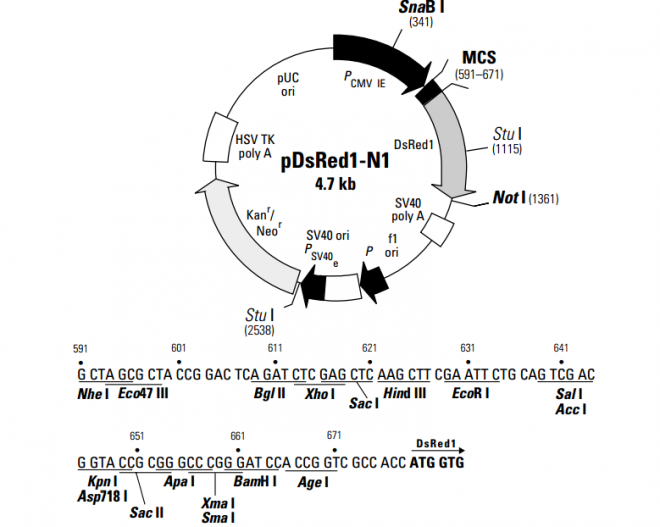pDsRed1-N1 载体
pDsRed1-N1 encodes a novel red fluorescent protein (RFP; 1) that has been optimized for high expression in mammalian cells (excitation maximum = 558 nm; emission maximum = 583 nm). RFP was isolated from an IndoPacific sea anemone-relative, Discosoma sp; DsRed1’s coding sequence contains 144 silent base pair changes, which correspond to human codon-usage preferences for high expression in mammalian cells (2). Sequences upstream of DsRed1 have been converted to a Kozak consensus translation initiation site (3) to increase translation efficiency in eukaryotic cells. The MCS is between the immediate early promoter of CMV (PCMV IE) and the DsRed1 coding sequence. Genes cloned into the MCS as described below are expressed as fusions to the N-terminus of DsRed1. SV40 polyadenylation signals downstream of the DsRed1 gene direct proper processing of the 3' end of the DsRed1 mRNA. The vector backbone contains an SV40 origin for replication in mammalian cells expressing the SV40 T antigen. A neomycin-resistance cassette (Neor ) allows stably transfected eukaryotic cells to be selected using G418. This cassette consists of the SV40 early promoter, the neomycin/kanamycin resistance gene of Tn5, and polyadenylation signals from the Herpes simplex virus thymidine kinase (HSV TK) gene. A bacterial promoter upstream of the cassette confers kanamycin resistance to E. coli. The pDsRed1-N1 backbone also has a pUC origin of replication for propagation in E. coli and an f1 origin for single-stranded DNA production.
载体应用
Fusions to the N terminus of DsRed1 typically do not alter the fluorescence properties of native DsRed1, allowing in vivo localization of the fusion protein.The target gene should be cloned into pDsRed1-N1 in frame with the DsRed1 coding sequence, with no intervening in-frame stop codons. The inserted gene should include an initiating ATG codon. Recombinant pDsRed1-N1 can be transfected into mammalian cells using any standard transfection method. If required, stable transfectants can be selected using G418 (4). Unmodified pDsRed1-N1 can also be used to express DsRed1 in a cell line of interest (e.g., for use as a transfection marker).


